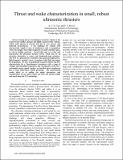Thrust and wake characterization in small, robust ultrasonic thrusters
Author(s)
Tan, A. C. H.; Hover, Franz S.
DownloadHover_thrust and wake.pdf (881.5Kb)
PUBLISHER_POLICY
Publisher Policy
Article is made available in accordance with the publisher's policy and may be subject to US copyright law. Please refer to the publisher's site for terms of use.
Terms of use
Metadata
Show full item recordAbstract
Among the new technologies in marine robotics is the trend toward smaller, cheaper and highly maneuverable vehicles, which could operate in swarms and also in very narrow and cluttered environments. A key challenge for vehicles with characteristic length of tens of centimeters scale is propulsion, where the designer faces high complexity in small vehicular space, as well as fouling concerns. Toward this end, we review and characterize the ultrasonic thruster (UST), which may be an attractive alternative to rotary and biomimetic-type actuators. The UST is a piezoelectric transducer that generates high-power, high-frequency acoustic waves, to produce bulk fluid movement for propulsion. We have systematically measured thrust and flow characteristics for a 7mm-diameter transducer with a range of voltages and sinusoidal frequencies, and varying duty cycles for a rectangular source signal; further, we installed three transducers into a 21cm underwater vehicle prototype. The experimental results allow us to outline the major parameters and considerations in our small vehicle and infer the mission length and speed using the UST technology.
Date issued
2010-09Department
Massachusetts Institute of Technology. Department of Mechanical EngineeringJournal
OCEANS 2010
Publisher
Institute of Electrical and Electronics Engineers (IEEE)
Citation
Tan, A. C. H., and F. S. Hover. Thrust and Wake Characterization in Small, Robust Ultrasonic Thrusters. In Pp. 1–9. 2010, IEEE. © Copyright 2010 IEEE
Version: Final published version
ISBN
978-1-4244-4333-8
978-1-4244-4332-1